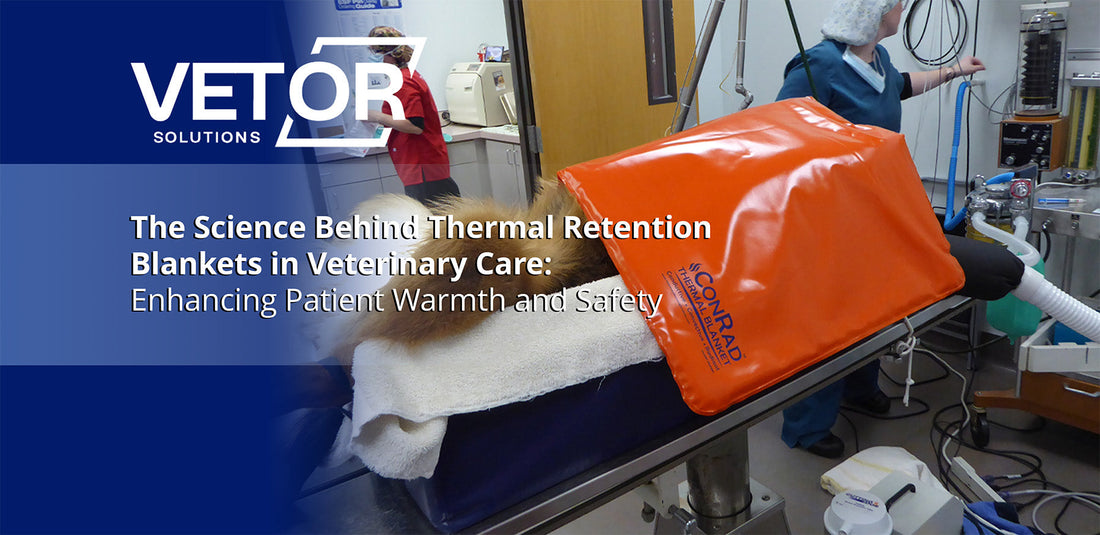The Science Behind Thermal Retention Blankets in Veterinary Care:
Enhancing Patient Warmth and Safety
Introduction
Maintaining appropriate body temperature is a critical component of patient care in veterinary clinical settings. Unintentional hypothermia, which is a drop in core body temperature below 99 degrees F, can significantly increase the risk of complications such as cardiac arrhythmias, impaired wound healing, coagulopathy, higher infection rates and prolonged post anesthesia recovery. Controlling heat loss is not merely about comfort but a matter of patient survival and a favorable surgical outcome.
One simple yet effective tool in the management of patient temperature is the thermal retention blanket. It stands apart from the foil blanket, space blanket, or mylar blanket in that in addition to a heat reflective layer it also has a heat insulative layer in an external fluid-proof enclosure. (ConRad Thermal Blanket). The science behind its thermal performance is grounded in well-established physical principles. This blog explores how these thermal retention blankets work, the mechanisms of heat retention, and their role in promoting warmth and safety for patients.
The Problem of Heat Loss in Veterinary Settings
Patients lose heat through four main mechanisms: radiation, convection, conduction, and evaporation. In a clinical environment, when a patient is exposed during surgery these processes can rapidly lead to hypothermia.
- Radiation is the emission of infrared heat from the body to surrounding cooler surfaces. It accounts for up to 60 - 70% of total body heat loss under normal conditions.
- Conduction occurs when the body is in contact with cold surfaces (e.g., an operating table).
- Convection involves heat loss to moving air around the body.
- Evaporation carries with it body heat and this results from fluid loss, perspiration or evaporation of surgical prep solutions
Patients under anesthesia are especially vulnerable to hypothermia due to impaired thermoregulation. Preventing heat loss, particularly radiative, is vital in maintaining core body temperature and preventing complications.

Why temperature matters
Every surgical team knows that maintaining a patient’s core body temperature during surgery is essential for patient safety and recovery. Hypothermia during and after surgery can have serious consequences:
- Increased blood loss, due to impaired coagulation function.
- Higher infection rates, due to cold stresses which inhibit the immune response.
- Prolonged post-anesthesia recovery, due to the enzymatic slowdown of anesthetic drug metabolism as well as increased oxygen consumption during post‑anesthetic shivering.
- Cardiovascular stress and arrhythmias, due to vasoconstriction which raises heart workload and instability of the myocardial action potential and electrical pathways.
- Impaired wound healing, due to vasoconstriction which decreases oxygen supply, impaired neutrophil and phagocyte activity as well reduced fibroblast activity and collagen formation.
For these reasons, maintaining normothermia (normal body temperature) during the perioperative period is a patient‑safety and quality‑care issue.
Thermal Retention Blankets: Design and Materials
Thermal retention blankets, specifically ConRad Thermal Blankets, have two internal layers and two exterior fluid-proof layers.
Heat Reflective Layer: The layer immediately adjacent to the patient is a heat reflective layer composed of a durable metallic film which reflects 97% of the heat presented to it. This material has a low emissivity, meaning that it reflects radiant energy rather than emitting radiant energy.
Heat Insulative Layer: This layer is adjacent to the heat reflective layer to insulate against any loss of body heat that was not reflected back to the patient
External Fluid Proof Layers: These two external fluid proof layers enclose and protect the inner heat reflective and insulative layers as well as guarding against evaporative heat loss.
Physical Principles of Heat Retention
The effectiveness of thermal retention blankets stems from basic thermodynamics and the creation of a barrier to conductive, convective, radiant and evaporative patient body heat loss in the following manner:
Conductive Heat Loss:
The thermal retention blanket, by virtue of its fibrous insulation, heat reflective layer or radiant barrier and fluid impermeable outer material forms a barrier to the direct flow of heat from the body to the surrounding air and solid materials. In addition to being draped over the patient and being circumferentially wrapped, it can also be placed underneath the patient to prevent conductive heat loss or direct transfer of heat to the underlying table or patient support surface.
Convective Heat Loss:
The thermal retention blanket, with its fibrous insulation, radiant barrier and fluid impermeable external material drapes supplely and pliantly over the patient to entrap air between the patient and the thermal retention blanket to form a thermal barrier between the patient and the circulating ambient air. Thereby body heat is trapped under the thermal retention blanket and is not given off to the ambient atmosphere.
Radiant Heat Loss:
The thermal retention blanket has as one of its inner layers a radiant heat reflective layer which is equally reflective of infrared radiant energy or heat on each side. The radiant heat reflective layer has been shown by ASTM C1371 testing to reflect ninety-five (95) percent of the heat presented to it. This radiant layer is next to the external fluid proof layer that is immediately adjacent to the patient body surface making this radiant layer in the appropriate position for reflection of the patient body heat back to the patient.
Evaporative Heat Loss:
Evaporative heat loss is not a major cause of heat loss in the peri-anesthetic and perioperative period. However, the thermal retention blanket prevents moisture evaporation and its concomitant heat loss from the body due to the fluid impermeable outer material and its pliant draping property which traps body heat and moisture and prevents evaporative cooling.
Thermal Resistance:
The entire thermal retention blanket has been tested in accordance with the ASTM D1518 standard test which measures thermal resistance. This test measures the ability of an object to resist the flow of heat through it. Thermal resistance is measured in CLO values. For example, the CLO value of someone being nude is Zero (0), the CLO value of someone wearing light summer clothing is 0.5 and the CLO of an extreme cold weather polar suit is 3 to 4. The CLO value of the thermal retention blanket is 3.6. This is laboratory evidence of its thermal effectiveness.

Veterinary Uses of Thermal Retention Blankets
Thermal retention blankets are a passive patient warming modality in that they do not require an external or active heat source for patient warming. The use of the thermal retention blanket is simple; merely drape it over the patient. Situations in which passive warming and patient body heat retention is needed may include the following:
- Surgical procedures: when only a portion of the body is available for covering with the thermal retention blanket, because the remainder of the body is part of a sterile field or being operated upon under general anesthesia. (Example – abdominal or orthopedic surgery)
- Short Procedures: when the patient is anesthetized for short procedures and active warming is unnecessary or complicates the performance of the procedure.
- CT Imaging: when the patient is receiving CT imaging and there is not sufficient space for active warming or active warming may complicate the procedure.
- X-ray Imaging: when the patient is receiving X-ray imaging and laying on a cold table to prevent conductive heat loss and in a cold room without active warming.
- Small patients: when the patient has a large surface area to mass ratio and is, therefore, especially susceptible to rapid heat loss such as small dog breeds.
- Preop Prep: when the anesthetized patient is receiving preoperative sterile preparation and active warming cannot be used.
- Postop Recovery: when the patient is recovering postoperatively to prevent further loss of body heat.
- Cage Use: when the patient is in a cage, and the thermal retention blanket is placed on the cage floor to prevent conductive heat loss to the cold floor of the cage.
- Use with an Active Warming System: the thermal retention blanket works synergistically with an active warming system to augment heat retention ( for example: use of the thermal retention blanket with the HoverHeat Patient Warming System).
The thermal retention blanket has a multiplicity of uses and should be an important part of patient temperature management in every veterinary facility.

Patient Safety:
- No patient burns: since the thermal retention blanket is not an active heating modality there is no chance of a patient receiving burns.
- Emergency Use: thermal retention blankets can be used in emergencies and trauma situations to prevent hypothermia and shock.
- Patient Protection: the thermal retention blankets have four layers of thickness including an insulative layer all of which combine to protect the patient intraoperatively from bumps and injury by surgery equipment and personnel.
Practical Advantages:
- Synergy with Active Warming: thermal retention blankets help to maintain and augment the temperature gains provided by active warming systems (HoverHeat Patient Warming System).
- Prewarming: thermal retention blankets can be used in prewarming patients and used during patient transfers and during preop prep.
- No Power Required: it is ideal for surgery, cages, imaging and intensive care as well as trauma situations where power is not available or desired.
- Reusable and Durable: the thermal retention blanket is durable, reusable and easily cleaned.
- Cost Effective: the thermal retention blankets, although highly effective, are “a poor man’s warming system” since they are significantly cost effective when comparing active warming systems.
Conclusion
Thermal retention blankets are a deceptively simple yet scientifically robust tool in the veterinary arsenal. By reducing radiant, convective, conductive and evaporative heat loss, they help preserve body heat in critical moments; from emergency trauma care to preop prep, surgery and postop recovery. Their lightweight, low-cost design makes them especially valuable in settings where active warming systems are unavailable or impractical. Thermal retention blankets should play a key role in patient temperature management in every veterinary facility.
References
- Sessler, D. I. (2001). Complications and treatment of mild hypothermia. Anesthesiology, 95(2), 531-543.
- US Department of Health and Human Services. (2009). Wilderness Medical Society Practice Guidelines for Wilderness Emergency Care.
- World Health Organization. (2015). Thermal protection of the newborn: a practical guide.
- Kober, A., Scheck, T., Fulesdi, B., Lieba, F., Vlach, W., & Sessler, D. I. (2001). Effectiveness of a metallized space blanket in preventing hypothermia in prehospital care. Resuscitation, 50(3), 311-315.
- Harper, C. M., & Andrzejowski, J. C. (2008). The role of perioperative warming in surgical site infection prevention. Journal of Perioperative Practice, 18(5), 199-204.
- NICE (National Institute for Health and Care Excellence). (2008). Inadvertent perioperative hypothermia: The management of inadvertent perioperative hypothermia in adults. NICE Clinical Guideline No. 65.

